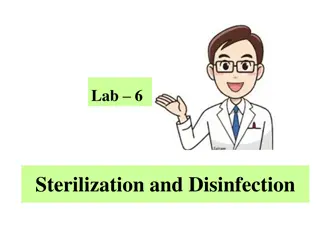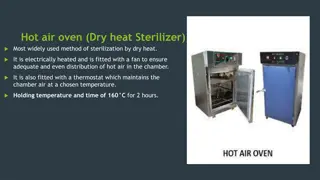Understanding Sterilization, Asepsis, and Antisepsis in Ancient and Modern Perspectives
Sterilization is the process of eliminating all microorganisms from an object or surface. Disinfection targets pathogenic microbes without spores. A good antiseptic/disinfectant should be chemically stable, affordable, non-staining, cidal, active against various pathogens, and able to spread effectively. Sterilization methods include physical agents like sunlight and heat, as well as chemical agents such as alcohols and phenol. Heat sterilization can be dry or moist, with techniques like boiling and flaming.
Download Presentation

Please find below an Image/Link to download the presentation.
The content on the website is provided AS IS for your information and personal use only. It may not be sold, licensed, or shared on other websites without obtaining consent from the author. Download presentation by click this link. If you encounter any issues during the download, it is possible that the publisher has removed the file from their server.
E N D
Presentation Transcript
sterlization, asepsis and antisepsis as per ancient and modern point of view
Sterilization It is a process which kills or removes all micro- organisms including bacterial spores from an article, surface or medium.
disinfection disinfection which destroys pathogenic micro- organisms but does not kill or remove spores.
good antiseptic/ disinfectant should be: (i) Chemically stable. (ii) Cheap. (iii) Nonstaining with agreeable colour and odour. (iv) Cidal and not merely static, destroying spores as well. (v) Active against all pathogens-bacteria, fungi, viruses, protozoa.
(vi) Require brief time of exposure. (vii) Able to spread through organic films and enter folds and crevices. (viii) Active even in the presence of blood, pus, exudates and excreta.
Sterilization can be accomplished by physical agents (viz. sunlight, heat, filtration and radiation) and chemical agents (such as alcohols, aldehydes, halogens, phenol, surface acting agents and gases)
Methods of sterilization Heat sterilization Chemical sterilization Radiation Sterilization
Heat sterilization Dry heat sterilization Moist heat sterilization
Dry Heat Sterilization Flaming : The instrument is held in a bunsen flame till it becomes red hot. Incineration : it is used to destroy soiled dressings, beddings and pathological materials Hot air oven : kills bacteria,spores and viruses. The item must be double wrapped and kept at 150 C for 1hours or 180 C for 20 min.
Moist heat sterilization methods Boiling: It kills bacteria and viruses. Heavier metallic ophthalmic instruments, e.g., Bard-Parker handles, lid guards etc. can be sterilized by boiling in water for 30 minutes. This method, however, blunts the cutting instruments.
Steaming. It kills most bacteria and viruses, but not spores. The instruments are placed on a shelf above the level of water and steamed for about 30 minutes. Most of the metallic instruments e.g., scissors and knives can be sterilized by this method.
Autoclaving (steam under pressure).It is the most widely used method for sterilization. It is based on the principle that at boiling point of water, the vapour pressure equates the atmospheric pressure. So, if the pressure is increased, boiling point tends to rise, which increases the penetrating power of the steam. Autoclaving at 121 C under 15 1b/in2 pressure for 20 min. or at 116 C under 10 1b/in2 pressure for 40 min. kills bacteria, spores and viruses. This method is suitable for sterilizing various instruments, linen, glass wares, rubber goods, gowns, towels, gloves dressings and eyedrops.
Chemical sterilization Savlon. It comprises of cetavlon or cetrimide and chlorhexidine. Cetavlon is a surface active agent and chlorhexidine is a phenol. It is active against most gram-positive organisms. It is used for cleaning/preparation of skin. Scissors, catheters, knives etc. may also be sterilized with it. 2. Spirit (95% alcohol). It kills bacteria and spores, but not viruses. It is mostly used with savlon.
3. Methylated spirit. It is 70 percent isopropyl alcohol. Schiotz tonometer can be sterilized by it. 4. Formaldehyde i. Formalin. 10 percent solution of formalin has a marked bactericidal, sporicidal and some viricidal activity. It is suitable for cryoextractor probes and heat sensitive instruments. ii. Formaldehyde gas. It may be used for fumigating wards, sick rooms and laboratories. But this gas is irritant and toxic when inhaled.
Glutaraldehyde (2%). It is available as Cidex solution. It has a special activity against tubercle bacilli, fungi and viruses. It is mostly used for sterilising endoscopes because it has no damaging effect on the lenses. It can be safely used for catheters, face-masks, anaesthetic tubes and metal instruments. However, it is not suitable for silicone tubing. It is specially used to sterilize sharp instruments, as it does not affect the sharpness. In three hours, the instruments are free of pathogens and spores. Instruments should be thoroughly washed with sterile distilled water before use.
6. Hydrogen peroxide. A 3 percent solution of H2O2 is used for sterilisation of applanation tonometers, prisms and ophthalmoscopy lenses. It is specially active against AIDS and herpes viruses.
Ethylene oxide gas: It is a highly inflammable gas and is usually mixed with an inert gas like nitrogen or carbon dioxide. It denatures the protein molecules. It is effective against almost all bacteria, spores and viruses. Goniotomy lenses, indirect ophthalmoscopy lenses, DCR tubings and cryoprobes can be sterilized with it. 8. Acetone. Use of acetone is a quick and cheap method of sterilising instruments. Instruments should be kept in acetone for 5 minutes and then thoroughly washed with sterile water before use.
Radiation sterilization 1. Ionising radiations: These include X-rays, gamma-rays, cosmic rays. They are highly lethal to DNA and thus kill all types of micro-organisms. They can penetrate solids and liquids without raising the temperature appreciably (cold sterilisation). They are used for sterilizing plastic syringes, swabs, catheters, tubings etc. 2. Non-ionising radiations: They act as a form of hot air sterilization since they are absorbed as heat. They include the infrared rays which is used for rapid mass sterilization of disposable syringes.























